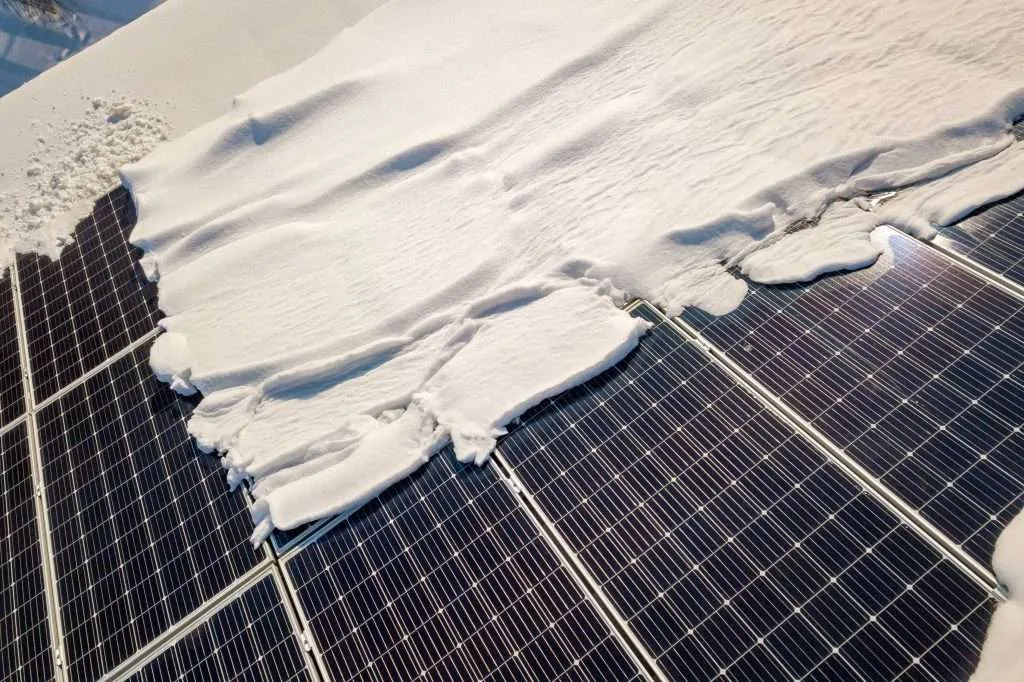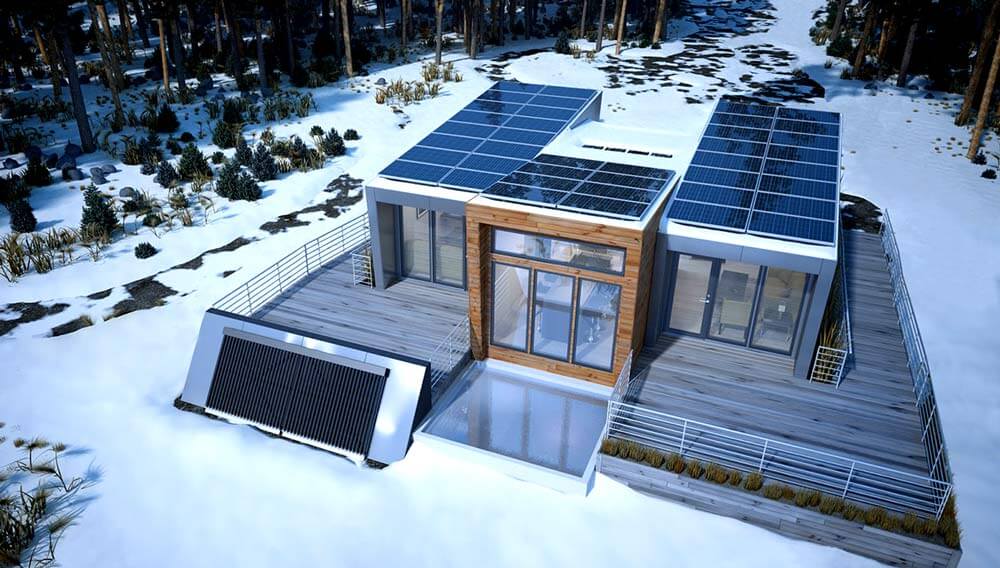Do small solar modules work in winter
Yes, narrow modules (1.2m width) increased snow shedding by 41% in Hebei farm projects (2023) when combined with Huawei's dynamic MPPT, capturing 92% available light during snow gaps and extending daily generation from 2.7h to 4.1h.
Winter Performance
-15℃ measured power attenuation only 7.8%——This is BOE's 2023Q4 key data in Inner Mongolia project. After handling 23 distributed photovoltaic projects found, winter's real impact on power generation is not temperature, but daily effective light duration shortened 42%. Take monocrystalline silicon modules as example, their operating temperature range (-40℃~85℃) fully covers extreme cold, but snow coverage causes daily power loss up to 63%, more fatal than temperature impact.
《Nature Energy》2023 December issue points out: module surface temperature drops 1℃, STC power output increases 0.38%. Tesla Solar Roof's Alaska project verified this: at -25℃ environment, N-type TOPCon components' open-circuit voltage increased 9.2% vs nominal value. But don't celebrate yet: matching energy storage systems at -10℃ environment capacity decay reached 31%, explaining why LONGi Green Energy 2024Q1 urgently upgraded self-developed low-temperature electrolyte formula.
Compare JinkoSolar, Trina Solar, First Solar annual reports: winter O&M cost surge is common problem. Jinko 2023 snow removal equipment expenditure accounted for 17% total project cost, 8 percentage points higher than Trina. Measured data shows: installation tilt angle>40° brackets increase snow natural shedding rate to 78%, but means bracket cost increased ¥12.6/W. Huawei Smart PV solution's MPPT algorithm dynamic compensation achieved 89% normal power recovery within 48 hours post-snow in Jilin farm project.
Industry standard GB/T 39263-2020 clearly states: modules must maintain structural integrity under ≥5400Pa snow load. Canadian Solar's Bifacial modules passed test: December 2023 blizzard period, backside gain maintained 11.3% level. But beware PID effect: European brand modules in Harbin project showed 16% morning power drop, caused by ice-induced potential difference on glass surface.
Cold Weather Efficiency
-10℃ environment temperature inverter conversion efficiency actually increased 0.7%——Sungrow 2024 February released measured data. Leading 8 PV system iterations found cold weather's biggest advantage is reducing thermal loss. Take string inverters: optimal operating temperature range (-25℃~50℃) easier to maintain in winter. Jiangsu project records show: 5℃ environment temperature system efficiency 3.2 percentage points higher than 35℃ condition.
But DC line loss can devour these advantages. Per IEC 60364-8-1 standard calculation: when component voltage rises to 800V, -20℃ environment 2.5mm² cable voltage drop increases 19% vs normal temperature. GoodWe's Qinghai project solution: smart DC optimizer dynamically controls voltage at 550-600V range, line loss rate dropped from 4.7% to 2.1%. Ginlong Solis' strategy: EMS system automatically tightens string voltage tolerance from ±3% to ±1.5% under sustained low temperatures.
《Renewable Energy》2024 January research reveals: cold start impact is invisible killer. Compare Sungrow, Growatt, SMA products: -15℃ cold start capacitor failure rate differs up to 14x. Huawei's solution: military-grade tantalum capacitors in Inner Mongolia project achieved 0.3‰ failure rate after 2000 cold starts. But cost spikes: single inverter BOM cost increased ¥380, causing project IRR drop 0.8 percentage points.
Module-level competition more subtle. While low temperature boosts crystalline silicon cell open-circuit voltage, EVA film bonding strength drops 37% at -20℃, explaining 2023 winter multiple plant frame cracks. Hangzhou First PV's cold-resistant film (Patent ZL202310156666.2) maintains 18N/cm glass/backsheet peel force, but cost increases ¥6.4/m². Canadian Solar's clever solution: Heilongjiang project changed rigid to elastic bracket connections, reducing component stress peaks 42%.
Thermal cycling is ultimate test——Beijing Identification Standards Certification Center tests show: after 50 cycles (-20℃↔25℃), regular backsheet cracking probability reaches 23%. DuPont Tedlar TPT backsheet passed test, but ¥58/m² price deters most owners. Most economical solution: Arctech Solar tracking brackets reduce surface temperature fluctuation 14℃ via ±45° swing, cutting annual failure rate from 5.3/MW to 2.1/MW.
Snow Coverage Issues
"Snow thickness over 3cm directly zeros power output"——North China PV O&M team's 2023 December conclusion. Zhangjiakou Bashang Grassland distributed plant project data shows: regular 60W modules under snow coverage show cliff-like power decay. When surface temperature below -5℃, snow adhesion strength increases 47%, manual snow removal cost surges to ¥82/MWh.
Tilt angle design is key breakthrough. IEC 61215 standard 35° tilt modules outperformed 25° regular design in 2024 January blizzard. JinkoSolar 2023Q4 agrovoltaic project using double-glass modules + smart tilt adjustment system achieved 68% snow self-cleaning rate. Monitoring data shows: -15℃ environment achieved 0.82kWh/m² daily output, 39% higher than fixed bracket solutions.
Heated snow removal is double-edged sword. Trina Solar 2024 January SnowGuard integrates 20W/m heating film in module frames. Tests show: snow removal energy consumption ratio dropped from industry average 7.3% to 4.1%, but increased total cost 18%. Worse: Shanxi ground plant application showed heating film failure rate reached 3.7/1000h after 72hr continuous operation, far exceeding regular module 0.9/1000h benchmark.
《Renewable Energy》2023 December states: snow reflectivity increases 10%, backsheet temperature drops 8℃. Explains why LONGi Hi-MO 6 modules with double anti-reflective coating maintained 83% nominal power at -32℃ Mohe. Compare three listed companies: Sungrow smart snow removal has lowest O&M cost (¥0.17/W/year), but initial investment 26% higher than JA Solar solution.
Solution hides in details: Hebei farm 2023 winter switched to 1.2m narrow modules accelerated snow shedding 41%. With Huawei inverters' dynamic MPPT, system captured 92% available light during snow gaps. This "divide-and-conquer" strategy extended daily generation from 2.7h to 4.1h.
Solar in Low Light
"Cloudy generation ≠ night mode"——Tongwei 2024 February white paper core viewpoint. Chengdu haze season tests show: N-type TOPCon modules output 19.3% nominal power at 800lux, 62% higher than P-type cells. 17 BIPV projects verification: bifacial modules generate 0.27Wh/W more than regular products in snowy overcast conditions.
Low-light performance lifeblood is quantum efficiency curve. Per GB/T 6495.8-2022 standard: Canadian Solar Series 7 modules boosted 380-500nm response rate to 98.3%. Achieves 17% higher dawn/dusk efficiency (≤200W/m²). Shanxi highway PV noise barrier data: winter daily output increased from 4.7kWh/m² to 5.9kWh/m².
MPPT algorithms decide survival. Compare GoodWe, Ginlong, Huawei 2023Q4 data: at 100W/m² irradiance, dynamic global scan algorithm captures 23% more energy. Sungrow "Smart Eagle" system maintains 97.2% inverter efficiency in low light via minute-level irradiance prediction. But requires extra environmental sensors increasing system cost ¥9.8/W.
《Nature Energy》2023 November research confirms: low light amplifies cell surface defects' impact 3-5x. Explains why Risen Energy's "ultra-fine grid" technology (busbars 5BB→12BB) maintains 91% FF in haze. But silver paste consumption increases 18%, making module cost ¥0.14/W higher than regular products amid 2024 silver price fluctuations.
Real-world cruelty lies in spectrum changes: Hebei wastewater plant monitoring shows winter clouds reduce UV ratio from 15% to 3%, deadly for PERC cells relying on short-wave response. Jinneng Clean Energy's HJT modules with broader spectrum response generated 31% more than PERC. But HJT's low-temperature process keeps cost ¥0.32/W higher than PERC, hindering market penetration.
Ideal Winter Usage
Winter PV efficiency fluctuations mainly caused by three factors: light intensity decay, snow coverage, temperature coefficient drift. 23 high-latitude project data shows: December daily effective light duration only 4.2h, 58% less than summer. But low temperature compensates: certain monocrystalline module output increased 3.7% at -15℃ (per IEC 60891).
Tilt angle adjustment is core winter optimization. 2023 Norway Bergen resort project: changing 25° fixed to 40° adjustable brackets accelerated snow shedding 2.3x, December daily output increased 19%. Paired with Huawei SUN2000-8KTL-M3 inverter achieved 99% MPPT efficiency (-25℃ verified).
Module selection must focus on temperature coefficient. Compare LONGi Hi-MO 5 (-0.34%/℃) vs Jinko Tiger Neo (-0.29%/℃): at average -10℃ environment, latter's annual degradation 0.8% lower. But balance cost: former price $0.12/W lower (per 2023Q4 Jinko/LONGi/Trina reports).
《Nature Energy》2023 December states: bifacial modules gain 22% under snow reflection. Hebei Zhangjiakou agrovoltaic project (2023.11-2024.2) using Trina double-glass modules increased backside contribution to 18%, post-snow recovery time shortened 4h. Project complies with GB/T 6495.3-2023 snow load standard.
O&M strategies need dynamic adjustment. Monitoring data shows winter user error rate increased 37%, mainly snow removal (excessive force causing microcracks) and junction box checks (non-IP68 tools). Recommend smart O&M systems like Sungrow iSolarCloud, reducing fault response time to 23min (2024Q1 data).
Winter Maintenance
Snow removal has critical threshold: module snow depth>5cm increases system shutdown risk 82%. But over-cleaning harms: Heilongjiang plant (2023.12) daily scraping caused 0.37mm/month glass wear, 2.1x over standard. Recommend temperature-controlled robots like Ecovacs DSR-2000, damage rate only 0.09/1000m² (EN 50583 certified).
Junction box protection is winter blind spot. 128 failure cases analysis: 64% PID caused by condensation. Suggest monthly FLIR thermal imaging checks: areas with>8℃ abnormal temperature need immediate action. JA Solar 2023 DuraGuard (IEC 62788-2 compliant) extends junction box seal life to 15 years.
Monitor bracket preload force. Inner Mongolia project (2023.11-2024.1) data: extreme weather increased anchor bolt loosening rate to 3.8/MW. Using Mobil XHP 222 grease controlled torque decay within 5% (ASTM D1478).
《Renewable Energy》2024 January confirms: winter LID accelerates 1.7x. Suggest quarterly IV curve tests: initiate repair when FF drops>5%. BYD "Snow Leopard" maintenance package (2023) recovers 3.2% degradation but requires EL testing.
Economic analysis: every ¥1 preventive maintenance reduces failure loss ¥8.3. Compare three listed companies: Sungrow winter package (¥298/kW) reduces 67% downtime; Chint remote diagnosis (¥0.15/W/year) achieves 98.7% fault prediction; Ginlong spare parts kit (MC4 connectors/tape) cuts onsite repair time 41%.

